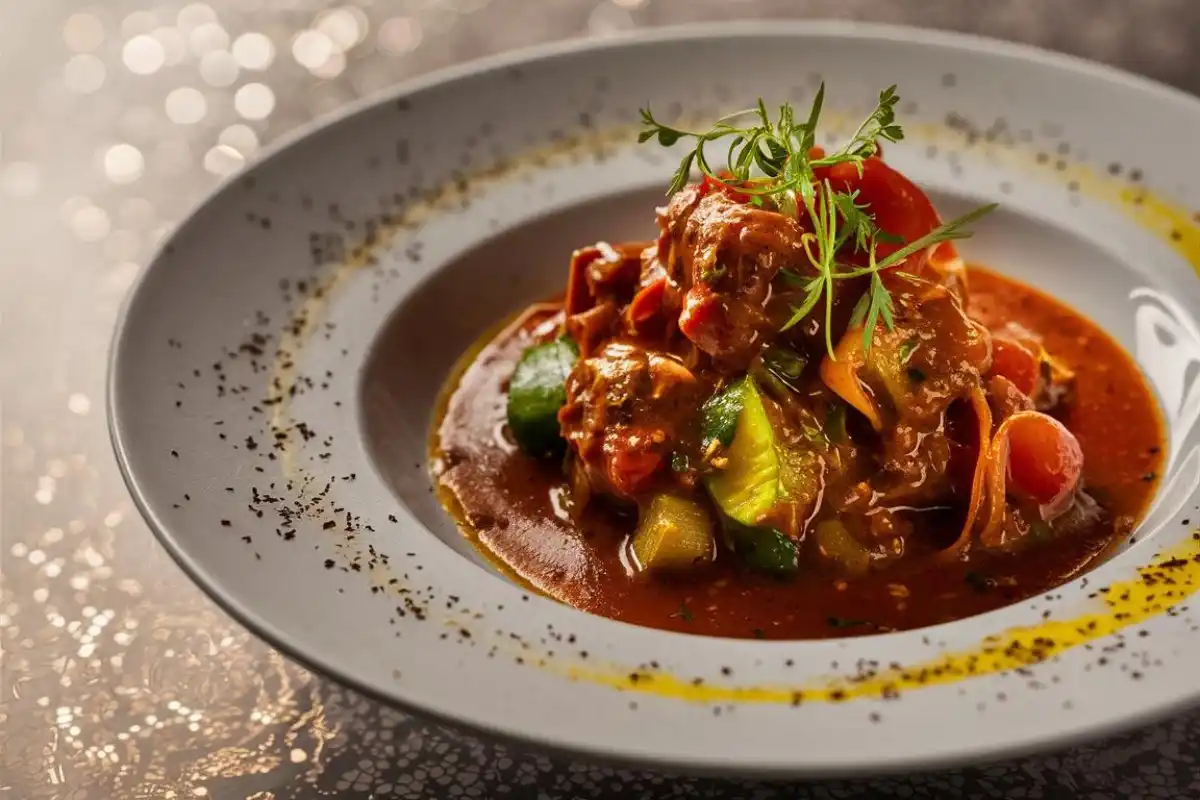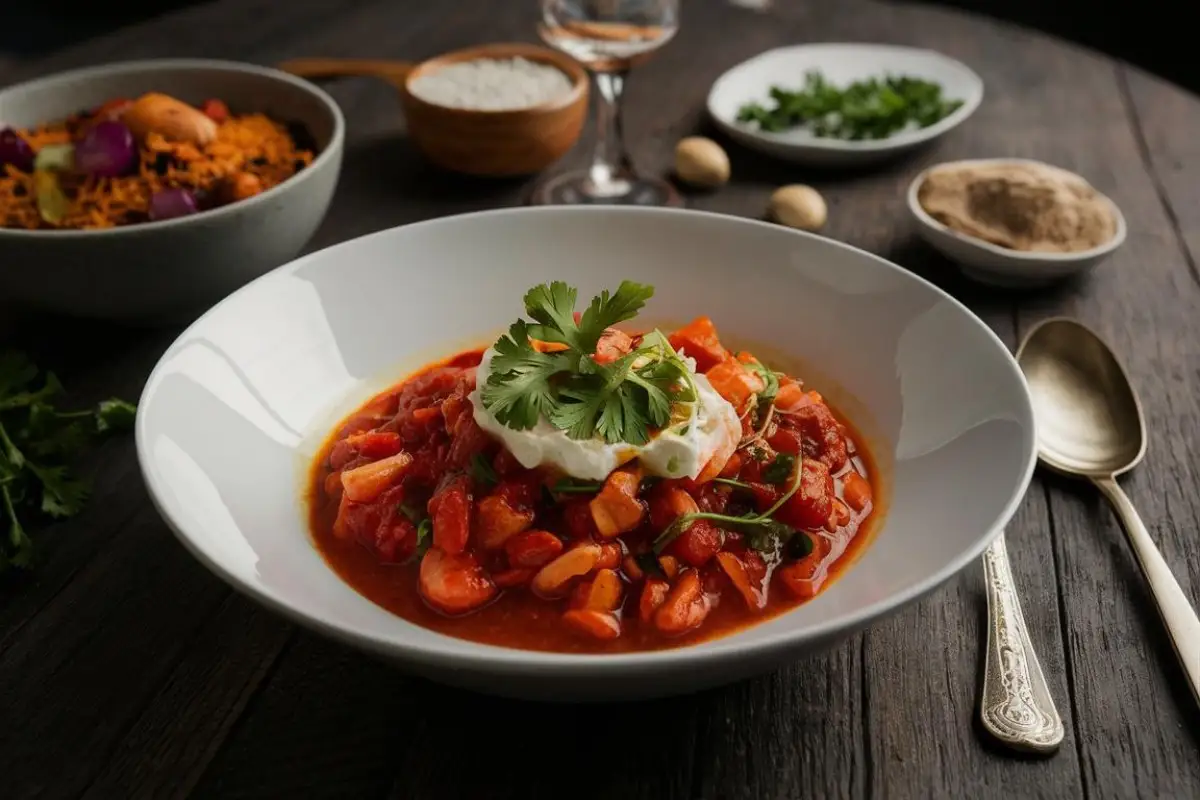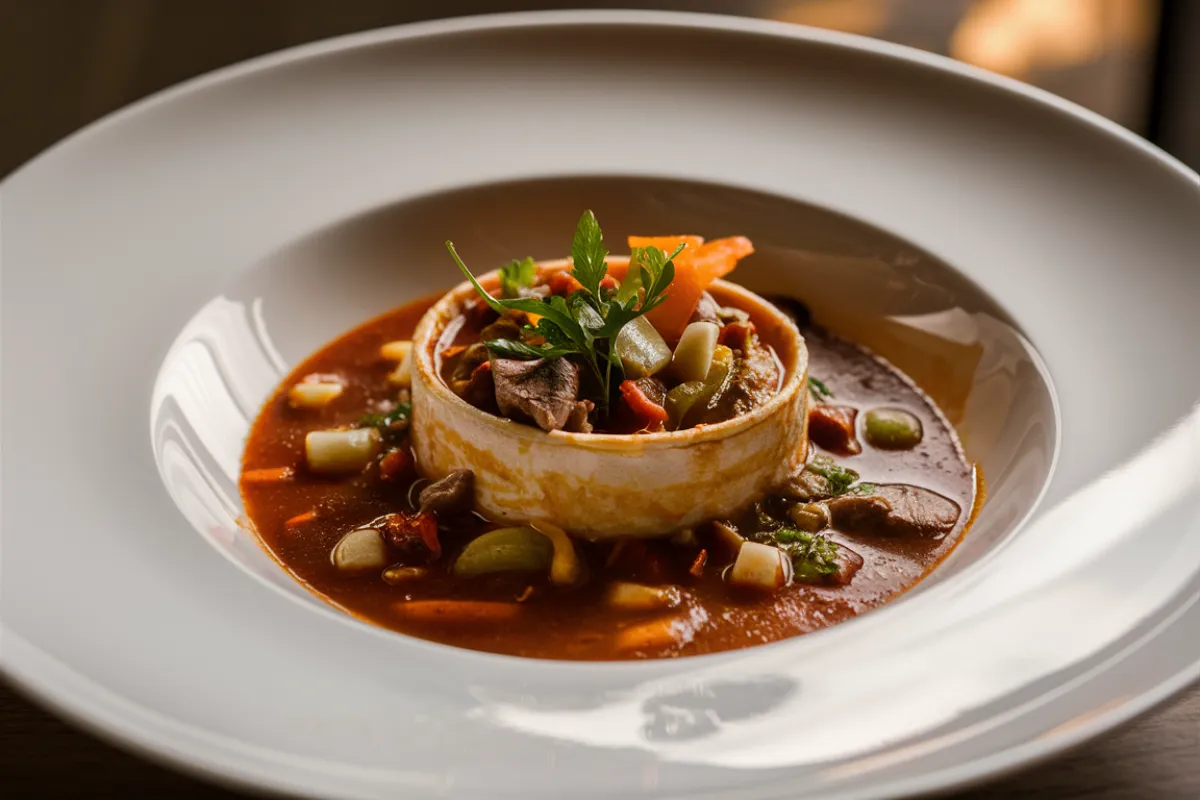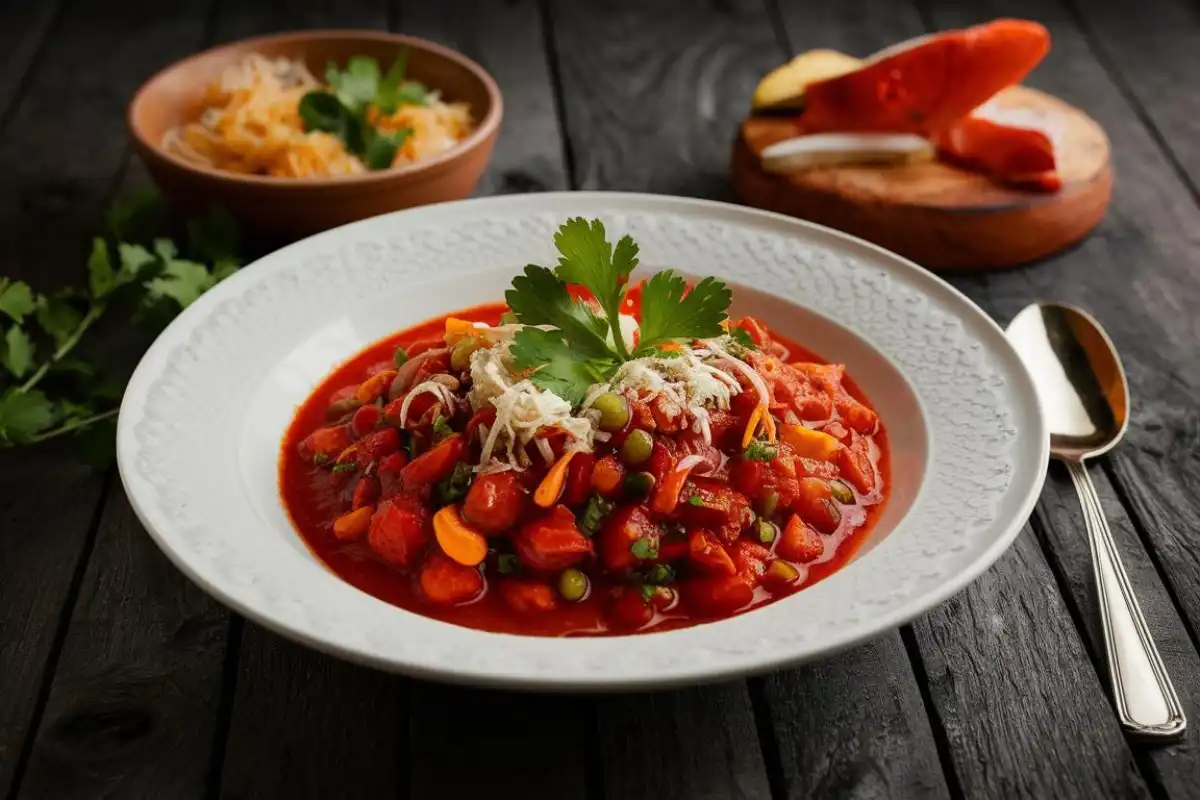Introduction to Goulash Recipe
The goulash recipe is a versatile dish with a rich history. Originating in Hungary, it has evolved over the years, particularly in the United States, where it has become a beloved comfort food. This article will guide you through everything you need to know about making a perfect goulash, from its essential ingredients to tips for customizing it to your taste.
History of Goulash Recipe
The origins of the goulash recipe can be traced back to Hungarian shepherds in the 9th century. These early versions of goulash were simple stews made with meat and onions, cooked over an open fire. Over time, the recipe evolved, incorporating ingredients like paprika a spice now synonymous with Hungarian cuisine.
Goulash was traditionally prepared by herdsmen who would cook the dish in large cauldrons over an open fire. The name “goulash” comes from the Hungarian word “gulyás,” which means “herdsman.” It was a practical meal, easy to prepare with ingredients readily available on the plains.
As it spread across Europe, goulash began to take on new forms. Different regions added their unique touches, from additional spices to varying cooking methods. By the time it reached America, goulash had transformed into a dish that was more about convenience than tradition. The American version, often referred to as American Goulash, typically includes ground beef, tomatoes, and pasta, making it a quicker, more accessible meal. Discover the Health Benefits of Paprika, one of the key ingredients in traditional goulash, and how it enhances the flavor and nutritional value of the dish.

Types of Goulash Recipe
Goulash varies greatly depending on the region, and even within Hungary, there are several different types:
- Hungarian Goulash: This traditional version is more of a soup than a stew, featuring chunks of beef, onions, paprika, and other spices. It’s often served with csipetke (Hungarian noodles) or bread. Hungarian goulash is known for its bold flavors, thanks to the generous use of paprika, and is often slow-cooked to develop its rich, deep taste.
- American Goulash: This variant is a one-pot meal made with ground beef, tomatoes, and pasta. It’s quicker to prepare and has a thicker, stew-like consistency compared to its Hungarian counterpart. American goulash is also known as “slumgullion” in some regions, reflecting its humble, hearty nature. It’s a dish that has evolved into a comfort food staple in many American households.
Regional Variations
- Austrian Goulash: Similar to Hungarian goulash but often includes potatoes and is slightly thicker.
- German Goulash: This version might include both beef and pork, and it’s commonly served with spätzle (a type of German pasta).
- Slovak Goulash: In Slovakia, goulash is typically thicker and is often served with knedle (dumplings).
These regional variations highlight how adaptable goulash is, making it a beloved dish across many cultures.
Essential Ingredients
To create an authentic goulash, whether Hungarian or American, you’ll need the following ingredients:
- Beef: The heart of any goulash, providing a rich and meaty flavor. For Hungarian goulash, use chunks of beef chuck or shin, which become tender during long cooking. For American goulash, ground beef is often used for a quicker cooking time.
- Onions and Garlic: These form the aromatic base of the dish. In Hungarian goulash, onions are used generously, sometimes in equal weight to the beef, to create a deeply flavorful base.
- Paprika: A crucial spice that gives goulash its characteristic flavor and color. Hungarian sweet paprika is preferred, but smoked paprika can be added for a different flavor profile.
- Tomatoes: Used in both Hungarian and American versions, tomatoes add acidity and richness. While Hungarian goulash uses fresh tomatoes or tomato paste sparingly, American goulash relies heavily on canned tomatoes and tomato sauce.
- Beef Broth: Adds depth to the flavor, especially in the American version. For an authentic Hungarian flavor, homemade beef broth is ideal.
- Pasta: Typically used in American goulash to make it a hearty, filling dish. Elbow macaroni is the traditional choice, but other small pasta shapes can be used as well.
Optional Ingredients
- Bell Peppers: Often added to American goulash for color and sweetness.
- Caraway Seeds: A traditional spice in Hungarian goulash, adding a distinctive flavor.
- Potatoes: In some variations, potatoes are added to the stew to make it more filling.
- Sour Cream: A dollop of sour cream on top of Hungarian goulash can add a creamy contrast to the spicy stew.
Step-by-Step Goulash Recipe
Here’s how to make a classic American goulash, perfect for a cozy family dinner:
Ingredients:
- 1 tbsp olive oil
- 1 cup onion, diced
- 1 green bell pepper, diced
- 2 lbs. lean ground beef
- 3 tsp garlic, minced
- 2 cans (15 oz each) tomato sauce
- 2 cans (15 oz each) petite diced tomatoes
- 3 cups beef broth
- 3 tbsp Worcestershire sauce
- 2 tsp seasoned salt
- 2 tbsp Italian seasoning
- 3 bay leaves
- 2 cups macaroni noodles, uncooked
- 1 cup cheddar cheese, shredded
Instructions:
- Prep the Ingredients: Start by prepping all your ingredients. Dice the onions and bell pepper, mince the garlic, and measure out all your spices. This makes the cooking process smoother and ensures nothing is forgotten.
- Heat the Olive Oil: In a large pot or Dutch oven, heat the olive oil over medium-high heat.
- Cook the Onions and Peppers: Add the diced onions and bell pepper to the pot. Sauté for about 5 minutes, until they are soft and translucent.
- Brown the Beef: Add the ground beef to the pot. Cook until browned, breaking it up with a spoon as it cooks. Drain any excess fat from the pot to prevent the goulash from becoming greasy.
- Add Garlic: Stir in the minced garlic and cook for another minute until fragrant.
- Incorporate Tomatoes and Broth: Pour in the tomato sauce, diced tomatoes, and beef broth. Stir to combine, making sure to scrape up any bits stuck to the bottom of the pot.
- Season the Goulash: Add the Worcestershire sauce, seasoned salt, Italian seasoning, and bay leaves. Stir well to distribute the spices evenly throughout the mixture.
- Cook the Pasta: Stir in the uncooked macaroni noodles. Bring the mixture to a boil, then reduce the heat to a simmer. Cover and cook for about 20 minutes, stirring occasionally, until the pasta is tender.
- Finish with Cheese: Remove the bay leaves, then stir in the shredded cheddar cheese until melted and fully incorporated.
- Serve and Enjoy: Ladle the goulash into bowls and serve hot. Garnish with fresh herbs, if desired.
This recipe serves about 8-10 people and is perfect for a family dinner or meal prep.

Tips and Variations
Making a goulash recipe offers endless possibilities for customization. Here are some tips and variations to suit your taste:
- Make it Leaner: Substitute ground beef with ground turkey for a lighter version. You can also use lean cuts of beef like sirloin.
- Add More Veggies: Incorporate vegetables like corn, peas, or carrots for added texture and nutrition. These vegetables add sweetness and a bit of crunch, balancing the richness of the dish.
- Creamy Twist: Stir in a cup of sour cream at the end for a richer, creamier goulash. This works particularly well in the American version, adding a tangy contrast to the savory flavors.
- Make it Spicy: If you prefer a bit of heat, add some red pepper flakes or a diced jalapeño to the mix.
- Herbs and Spices: Fresh herbs like parsley or dill can be added just before serving to brighten the dish. For a more complex flavor, try adding a bay leaf or a pinch of caraway seeds while the goulash simmers.
Serving Suggestions
- Traditional: Serve with crusty bread or over a bed of egg noodles to soak up the rich sauce.
- Modern Twist: Pair with a side of steamed vegetables or a fresh green salad for a balanced meal. A glass of red wine also complements the deep flavors of goulash.
Nutritional Breakdown
A serving of this American goulash provides approximately:
- Calories: 388 kcal
- Carbohydrates: 20g
- Protein: 22g
- Fat: 24g
- Sodium: 918mg
Paprika, a core ingredient, is not only flavorful but also packed with antioxidants. It’s a great source of vitamins A and E, contributing to the nutritional value of this hearty dish. Additionally, using lean ground beef or turkey can help reduce the overall fat content, making the dish healthier without sacrificing flavor.
Goulash for Special Diets
- Gluten-Free: Use gluten-free pasta to adapt this recipe for those with gluten intolerance. Ensure that all other ingredients, such as the beef broth and Worcestershire sauce, are also gluten-free.
- Low-Carb: Substitute pasta with zucchini noodles or cauliflower rice to make a low-carb version. This variation not only reduces the carb content but also adds extra vegetables to your meal.
- Vegetarian/Vegan: Replace the meat with plant-based alternatives like mushrooms, lentils, or a soy-based ground meat substitute. Use vegetable broth instead of beef broth and omit the cheese or use a vegan cheese alternative.
Best Ways to Serve Goulash

- Traditional: Serve with crusty bread to soak up the rich sauce. Goulash pairs well with rustic bread, such as sourdough or rye, which complements the hearty flavors of the dish.
- Over Noodles: Hungarian goulash is often served over egg noodles or with csipetke, a traditional Hungarian dumpling.
- With Potatoes: Another classic serving method is to serve goulash over boiled or mashed potatoes, which absorb the flavorful sauce.
- Modern Twist: Pair with a side of steamed vegetables or a fresh green salad for a balanced meal. Roasted root vegetables or a tangy coleslaw can also provide a nice contrast to the rich goulash.
Storing and Reheating Goulash
- Storing: Keep leftovers in an airtight container in the refrigerator for up to 4 days. The flavors often deepen and improve after a day or two, making it even more delicious.
- Reheating: Reheat gently on the stove over medium heat, adding a splash of beef broth if needed to restore the consistency. Be sure to stir occasionally to prevent sticking.
- Freezing: Freeze goulash in portion-sized containers for up to 3 months. Thaw in the refrigerator overnight before reheating. Goulash freezes well and can be a great make-ahead meal for busy nights.
Tips for Freezing
- Cool Completely: Before freezing, allow the goulash to cool completely to prevent ice crystals from forming, which can affect the texture.
- Use Heavy-Duty Bags: If using freezer bags, lay them flat in the freezer to save space and ensure even freezing.
Frequently Asked Questions (FAQs)
- What is the difference between Hungarian and American Goulash?
- Hungarian goulash recipe is more like a soup, with chunks of beef and a base of paprika and onions, while American goulash is a thicker stew with ground beef, tomatoes, and pasta. Hungarian goulash is typically spicier and more robust, while American goulash is milder and more tomato-based.
- Can I make goulash in a slow cooker?
- Yes, slow cooking allows the flavors to meld beautifully. Simply follow the recipe, but Set your slow cooker to low and cook for 6-8 hours, or choose the high setting and cook for 3-4 hours. This method is especially effective for Hungarian goulash, where slow cooking tenderizes the beef and intensifies the flavors.
- How long does goulash last in the fridge?
- Properly stored, goulash will last in the refrigerator for up to 4 days. For the best flavor, consume it within 2-3 days.
- Can I make goulash without meat?
- Absolutely! Substitute the meat with mushrooms or lentils for a hearty vegetarian option. Adding a variety of vegetables can also enhance the flavor and texture, making the dish just as satisfying as the meat-based version.
- What are some popular side dishes to serve with goulash?
- Traditional options include dumplings or crusty bread. For a lighter side, consider a green salad or steamed vegetables. Another option is to serve goulash over mashed potatoes or rice, which helps to balance the richness of the dish.
Conclusion
Goulash is a timeless dish that offers comfort with every bite. Whether you prefer the traditional Hungarian version or the American adaptation, this recipe provides a base that can be customized to suit your preferences. So gather your ingredients, follow the steps, and enjoy a hearty meal that’s sure to become a favorite in your household. The versatility of goulash means there’s a version for everyone, whether you’re looking for something quick and easy or a dish that’s steeped in tradition.

